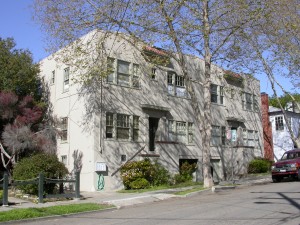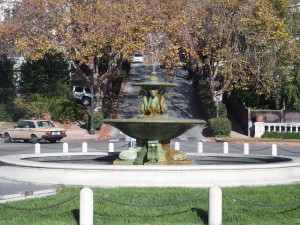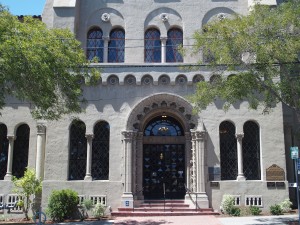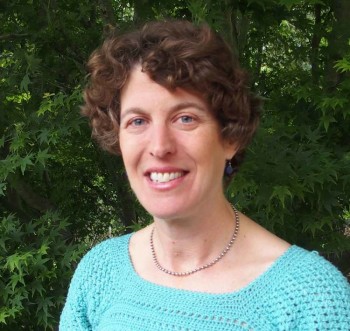Berkeley is a 10.5-square-mile city with a population of about 117,000; Oakland is next door and San Francisco is just across the bay. The University of California, known as Cal, was founded here in 1868. While the university is the heart of the city, Berkeley is much more than simply a campus town. Beyond the Cal borders, Berkeley is a regional and national center for theater and the arts, food and culture, religious study, disability rights, and—of course—progressive politics.

Bill Clinton and Hillary Rodham apparently spent the summer of 1971 in this apartment building in the Elmwood district, while both were Yale law students and Hillary was clerking for a local attorney.
Berkeley also happens to be a terrific city for walking.
Walking is in the fabric of Berkeley’s culture. When the city was designed in the late 19th and early 20th centuries, planners included a network of about 140 public paths throughout the Berkeley Hills, providing pedestrians with routes to retail and commercial areas as well as emergency escape routes. In the early 1970s, Berkeley installed some of the first curb cuts in the nation as part of an effort to make navigating the city easier for people with physical disabilities.

The fountain in Marin Circle was designed by John Galen Howard in 1911 to be a grand entrance to the California state capitol.
In recent years, pedestrian- and bike-oriented improvements have included upgrades to public paths, the construction of new paths in public rights-of-way, traffic lights just for walkers, “traffic calming” measures to slow down cars (such as mini-roundabouts and speed bumps), and a network of bike boulevards.
I’ve lived in Berkeley for nearly 25 years, and never tire of walking (and biking and running) around town. I’ve led walks here for local and regional groups for many years. A few years ago, my good friend and fellow walk leader Robert E. Johnson had the great idea of putting walks together in a book. We recently published Berkeley Walks: Revealing Rambles Through America’s Most Intriguing City, a book of 18 self-guided neighborhood walks in Berkeley. Published by Roaring Forties Press, the book features highlights from our city’s fascinating architecture, tree-lined neighborhoods, unusual gardens, secret pathways, and lively retail areas. We also highlight important spots in the city’s history.

Julia Morgan, architect of Hearst Castle in San Simeon, designed the Berkeley Women’s City Club in 1930.
Whether you live in Berkeley or have the opportunity to visit the city, Bob and I encourage you to get your recommended 30 minutes per day of walking by taking a spin around our town!
Although it’s hard to pick, we’ve narrowed down our top 10 sites of historic interest to see in a walk around Berkeley.
- Apartment where Hillary Rodham and Bill Clinton spent the summer of 1971 (The Elmwood walk)
- Mural commemorating 1969 People’s Park uprising (The South Side of Campus walk)
- Sproul Plaza, scene of numerous protests including 1964’s Free Speech Movement and Occupy Movement of 2011 (UC campus walk)
- Building where the Symbionese Liberation Army kidnapped Patty Hearst in 1974 Elmwood walk)
- Cottage where Ted “Unabomber” Kaczinski lived for two years in the late 1960s before moving to Montana (Elmwood walk)
- Childhood home in late 1920s and 1930s of Jack LaLanne, the original fitness guru (McGee-Spaulding walk)
- First curb cuts in the United States designed for people with disabilities, 1970 (Downtown walk)
- Marin Circle, center of Berkeley’s unsuccessful 1908 bid to become the state capital (Southampton and Thousand Oaks walk)
- Chez Panisse, Alice Waters’s 1971 restaurant that started a revolution in American cuisine (Gourmet Ghetto walk)
- Berkeley Women’s City Club, designed by pioneering architect Julia Morgan in 1930 (South Side of Campus walk)
Janet Byron is senior communications specialist for the Kaiser Permanente Northern California Division of Research. For events and information, go to berkeleywalks.com.
Photos by Robert E. Johnson











